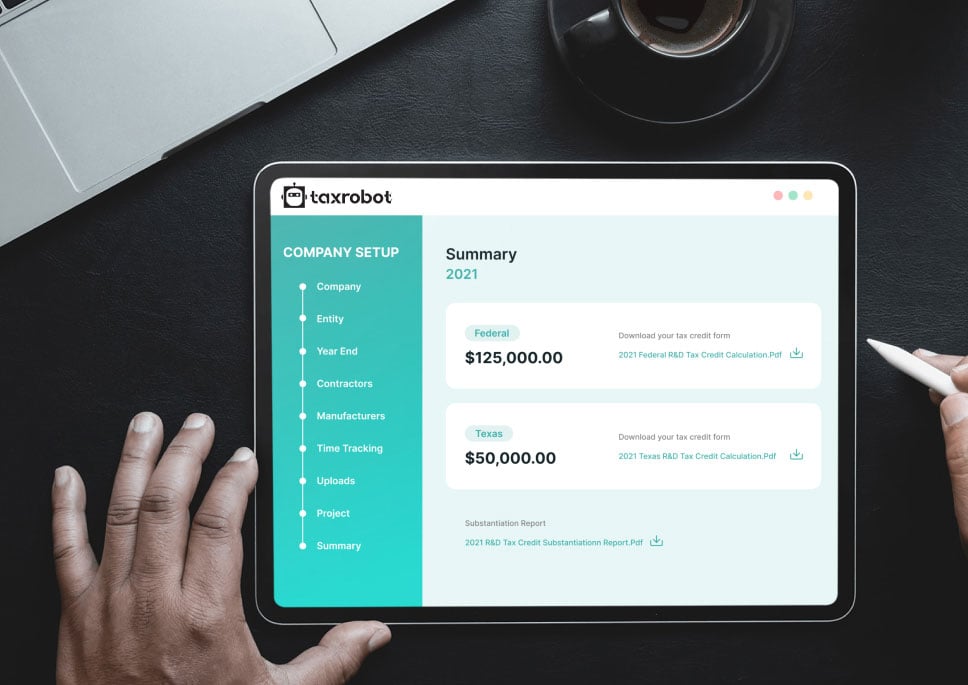Kansas R&D Tax Credit
With Tax Robot, Kansas R&D Tax Credit becomes more than a benefit—it becomes a catalyst for your business growth. Unleashing the incredible, simplifying the complex. This is not just tax planning; it’s financial evolution.
Maximize your State Credits today!
Put the R&D tax credit process on autopilot.
Trusted By:








Kansas R&D Tax Credit
Discover your eligibility for Kansas R&D tax credits and supercharge your enterprise.
Kansas Research and Development Tax Credit
Kansas provides a tax credit for Research and Development (R&D) to promote innovation and economic growth in the region. This initiative aims to incentivize companies to invest in R&D by reducing their tax burden.
Original Eligibility for the Credit
Initially, the Kansas R&D tax credit was only available to corporations subject to Kansas corporate income tax, specifically C corporations. Unfortunately, this excluded individuals, partnerships, S corporations, limited liability companies, and other pass-through entities from claiming it. But things changed for the better starting from the tax year 2023 when the credit was made available to all income taxpayers.
Federal Internal Revenue Code of 1986
To qualify for the credit, expenditures must be made for R&D purposes and adhere to the Federal Internal Revenue Code of 1986 provisions. The code defines qualified expenditures as those intended to discover information that eliminates uncertainty concerning the development or improvement of a product – a process, technique, formula, or invention.
Non-Qualifying Expenditures
Certain types of expenditures are not considered eligible for the credit. These include the acquisition of another’s patent, model, or production, advertising, consumer surveys, efficiency surveys, historical or literary research, management studies, ordinary testing for quality control, and research conducted after commercial production commences.
Research related to style, cosmetic, or seasonal design factors, as well as taste, adaptation of an existing component to a particular customer’s requirement, and studies conducted outside of the United States are also excluded. Additionally, any research in the social sciences, arts or humanities, or research funded by any grant, contract, or government, as well as routine data collection, do not qualify for the credit.
Credit Calculation
The amount of credit is calculated at 6.5% of the difference between R&D expenses for the year, the average expenditures made in the current year, and the two previous tax years. However, starting from January 1, 2023, the credit has been raised to 10% of the difference between the R&D expenses for the year and the average expenditures made in the current year and the two previous tax years.
Leverage TaxRobot to Maximize Your Tax Credit
Navigating the complexities of R&D tax credits can be challenging. That’s where TaxRobot comes in. Our AI-powered platform can help you identify qualifying R&D activities, calculate eligible expenditures, and prepare the necessary documentation for your claim.
By streamlining the process, TaxRobot makes it easier to claim your rightful R&D tax credits. Start maximizing your tax savings today by letting TaxRobot handle your R&D tax credit claims.
Frequently Asked Questions
Who is eligible for the Kansas R&D tax credit?
Initially, the Kansas R&D tax credit was only available to C corporations. However, starting from the tax year 2023, the credit is open to all income taxpayers who make qualifying expenditures on research and development activities in Kansas.
What types of expenditures qualify for the Kansas R&D tax credit?
The Kansas R&D tax credit covers expenses related to activities that are intended to discover information that eliminates uncertainty about the development or improvement of a product, process, technique, formula, or invention. These expenditures must be allowable under the Federal Internal Revenue Code of 1986.
Take a sneak peak

- Limited Time Offer
- Simple Onboarding
- Easy to Use
R&D Tax Credits FAQs
The four-part test as outlined in the Internal Revenue Code is used to determine qualified R&D activity.
The Four-Part Test
1). New Or Improved Business Component
Creation of a new product, process, formula, invention, software, or technique; or improving the performance, functionality, quality, or reliability of existing business component.
- Construction of new buildings or renovation of existing buildings
- Invention of a software application
- Manufacturing of a new product or the improvement of the production process for an existing product
- Creation of design documentation
2). Technological In Nature
The activity fundamentally relies on principles of the physical or biological sciences, engineering, or computer science. A taxpayer does not need to obtain information that exceeds, expands or refines the common knowledge of skilled professionals in a particular field.
- Physics (relationship between mass, density and volume; loading as the
result of gravitational attraction) - Engineering (mechanical, electrical, civil, chemical)
- Computer science (theory of computation and design of computational systems)
3). Elimination Of Uncertainty
Uncertainty exists if the information available to the taxpayer does not establish the capability or method for developing or improving the business component, or the appropriate design of the business component.
- The capability of a manufacturer to create a part within the specified tolerances
- The appropriate method of overcoming unsuitable soil conditions during construction
- The appropriate software design to meet quality and volatility requirements
4). Process Of Experimentation
A process designed to evaluate one or more alternatives to achieve a result where the capability or method of achieving that result, or the appropriate design of that result, is uncertain as of the beginning of the taxpayer’s research activities.
- Systematic process of trial and error
- Evaluating alternative means and methods
- Computer modeling or simulation Prototyping Testing
The R&D tax credit is one of the most misunderstood tax incentives available. Considering the myriad of industries and activities that legally qualify for the credit, the term “research and development” is a misnomer. Additionally, the R&D tax credit requires specialized knowledge and technology to identify and calculate the incentive properly.
Companies of various industries are unaware that they are eligible to claim the R&D tax credit. Under the Internal Revenue Code’s definition of R&D, many common activities qualify. You can get tax benefits for industries including software, technology, architecture, engineering, construction, manufacturing, and more.
The R&D tax credit can be claimed for all open tax years. Generally, open tax years include the prior three tax years due to the statute of limitations period. In certain circumstances, the law allows businesses to claim the R&D tax credit for an extended period of time. It is common for companies to amend previous tax years to claim this benefit and reduce the maximum amount of tax liability.
Partnerships and S corporations must file this form to claim the credit. The credit will flow from the Form 6765, to the Schedule K-1, to the Form 3800 on the individual’s tax return. For individuals receiving this credit that have ownership interest in a partnership or S corporation, Form 6765 is not required on the individual return.
Individuals claiming this credit can report the credit directly on Form 3800, General Business Credit if their only source for the credit is a partnership, S corporation, estate, or trust. Otherwise, Form 6765 must be filed with the individual’s tax return (e.g. sole proprietorship).
For tax years prior to 2016, the credit can be used to reduce the taxpayer’s regular tax liability down to the tentative minimum tax. The credit cannot be used to offset alternative minimum tax. Beginning in tax year 2016, eligible small businesses have expanded utilization for the credit. For these eligible small businesses, the regular tax liability can offset alternative minimum tax using the “25/25” rule.
What our customers have to say
I highly recommend TaxRobot to anyone considering an R&D Tax Credit software to complete their analysis.

We decided to switch to TaxRobot… Best decision we’ve ever made. More affordable, and less complicated.

I couldn’t believe how easy it was! In under an hour, we saved enough money to hire a new employee.
